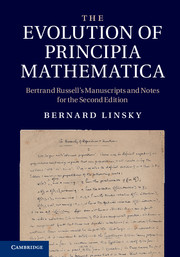 The Evolution of Principia Mathematica
The Evolution of Principia Mathematica Book contents
- Frontmatter
- Contents
- 1 Introduction
- 2 Writing the second edition
- 3 Logic since the first edition
- 4 Notation and logic
- 5 Improvements in the new edition
- 6 Induction and types in Appendix B
- 7 The reception of the second edition
- 8 The list of definitions for Carnap
- Introduction to the second edition
- Appendix A
- Appendix B
- Appendix C
- Hierarchy of propositions and functions
- Amended list of propositions: notes
- Bibliography
- Index
- Plate section
4 - Notation and logic
Published online by Cambridge University Press: 05 August 2011
- Frontmatter
- Contents
- 1 Introduction
- 2 Writing the second edition
- 3 Logic since the first edition
- 4 Notation and logic
- 5 Improvements in the new edition
- 6 Induction and types in Appendix B
- 7 The reception of the second edition
- 8 The list of definitions for Carnap
- Introduction to the second edition
- Appendix A
- Appendix B
- Appendix C
- Hierarchy of propositions and functions
- Amended list of propositions: notes
- Bibliography
- Index
- Plate section
Summary
This chapter presents the notation and logical system of Principia Mathematica, taking as illustrations many formulas that will appear in the second edition and the manuscripts, and so will prepare the reader who is new to the work. While the syntax of PM is not presented in that work explicitly, and is not up to contemporary standards in logic in certain respects, it is easy to distinguish primitive from defined expressions, and follow the introduction of defined symbols into the system. Symbols are then used in a uniform way after they are introduced. Russell's notation evolved from 1900 to 1910, starting with his adoption of Peano's symbolism, and then developed through his collaboration with Whitehead. The second edition of PM uses the notation of the first, with the exception of the new Sheffer stroke, and so the changes are primarily matters of logical theory. This chapter will also review the distinctive logical doctrines of the first edition of PM, particularly the theory of types, the theory of definite descriptions, and the “no-class theory of classes”, as necessary prerequisites for understanding the additions of the second edition.
Primitive symbols and punctuation
The basic symbols include the following. Some are primitive and some are defined:
✻ Pronounced “star”; indicates a chapter or section (“number”) and one of three kinds of sentence, either an axiom, a theorem, or a definition. “✻20 General Theory of Classes” is a number, with ✻20·01 its first definition, and ✻20·1 its first theorem.
Information
- Type
- Chapter
- Information
- The Evolution of Principia MathematicaBertrand Russell's Manuscripts and Notes for the Second Edition, pp. 73 - 107Publisher: Cambridge University PressPrint publication year: 2011